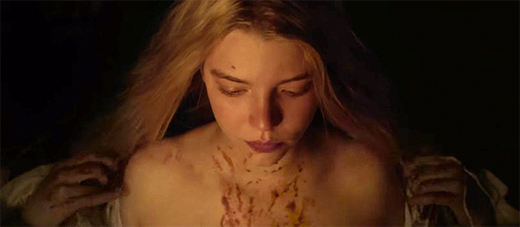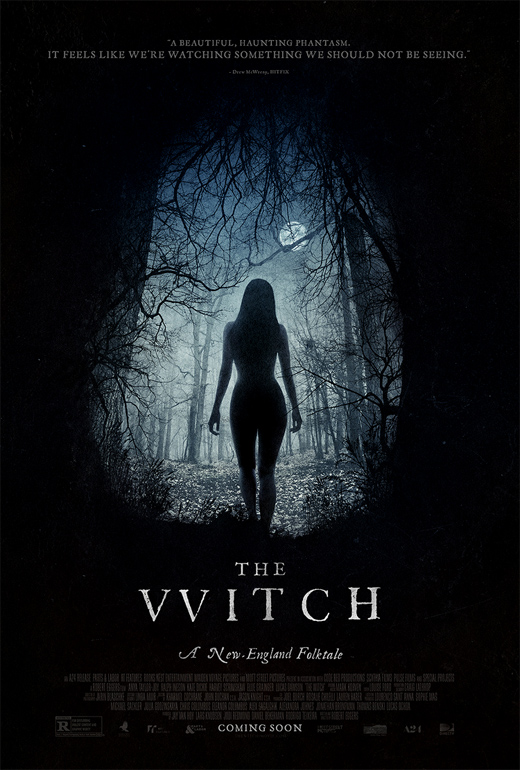Review: The Witch (2016)
Witches have long held as a staple antagonist in contemporary film and horror. From Mario Bava’s Asa in Black Sunday to Nancy Downs and the teen trio coven from 1994’s The Craft, witchcraft and its practitioners have served as a means for filmmakers to explore the role of the outsider to society and the isolation and sense of retribution that comes from being part of a fringe culture. Robert Eggers’ The Witch continues in that rich tradition and adds some deeper influences as one of the best films of this genre to come in years.
The Witch, which opens in wide release this Friday February 18th from A24 Films, is perhaps one of the most anticipated horror releases in recent memory. Debuting to wide acclaim at the 2015 Sundance Film Festival, The Witch is the feature debut of writer and director Eggers, who stands to become a name that genre film fans in the years to come will look to as an auteur to deliver thought provoking and harrowing visions with a sense of excitement and delight.
Living up to it’s subtitle “A New England Folk Tale,” The Witch is set in the year 1630, decades before the infamous Salem witch trials, as family man William (Game of Thrones‘ Ralph Ineson) finds himself and his family banished from their religious community and congregation and forced to eek out an existence farming corn on the edge of a barren forest. As their crop begins to fail, he turns to selling pelts and heirlooms with his son Caleb ( Harvey Scrimshaw) unbeknownst to his wife Katherine (Katie Dickie, known primarily to genre fans as Lysa Stark from Game of Thrones).
William’s banishment takes a disquieting turn when his infant son Samuel is stolen into the woods while under the watch of his eldest daughter Thomasin (a star making turn from newcomer Anya Taylor-Joy). Whether by wolf or thief, this disturbing disappearance begins a downward spiral for the family as Thomasin scares her younger siblings into compliance with tales that she is a witch who has signed herself over to be the devil’s concubine. Meanwhile, as she begins to blossom into womanhood, talk begins to rise of sending her off to another family to ease William and Katherine’s burden and she and Caleb head into the woods to find pelts to sell, only for Caleb to disappear and turn suspicion over these disappearances to Thomasin. Is she the titular witch, or is the severity of the situation, estrangement from their home and from communion with their religious roots and community, causing the family to unravel?
This is primarily the question that The Witch is interested in exploring for the bulk of it’s 92 minute running time. The film owes much in terms of pacing to Stanley Kubrick’s The Shining. It’s minimalist, spares and dissonant soundtrack sets up a feeling of owes much to the moody sound spaces of Kubrick collaborator Wendy Carlos and is also very reminiscent of Jonny Greenwood’s work on There Will Be Blood. Religion as a force for dissension within the family unit is a theme that The Witch also explores in interesting ways, whether as a scapegoat for bad behavior or as a means of literal imprisonment. The Shining can definitely be seen as a touchstone for the film, with the gradual unraveling of the family unit happening due to a disconnect from society and an ambiguous supernatural influence exerting a hold on the characters which may or may not be real during the majority of the film. It’s only when the film tips it’s cap towards a definitive answer in the film’s third act that one can see additional influences come into play, notably to Carrie and the 1922 docu-horror classic, Häxan.
Carrie‘s allegory to developing powers coming as the protagonist reaches puberty is echoed in a way through the character of Thomasin. As she becomes older, she is starting to become a burden to her family, a temptation of the flesh to another character, and an outsider among her own family. The film separates the different characters in different sections of the film as the unit dissoves further and further and leaves the audience with the question; is this because of supernatural influence or the situation they find themselves fraying the ends of this family unit to the breaking point.
The Witch finds itself in the enviable position of being a thinking man’s horror film and one that will inspires many favorable comparisons to Kubrick, De Palma, Arthur Miller’s The Crucible and even The Revenant with its beautiful use of natural light cinematography. It will cast a spell on you.
The Witch opens in wide release in Phoenix on February 18th.




